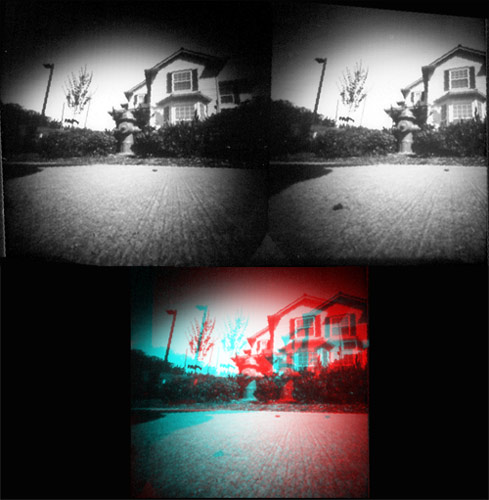My camera, constructed from a small metal tin (like Altoids come in), is a perfect example of the low-tech spirit of pinhole photography. The shutter consisted of a business-card sized refrigerator magnet hinged to the front cover by a short length of duct-tape*. Optimal pinhole size for the 19mm focal length of the box was .006 inches. I successfully drilled one at .008, but was never able to create a match, so ultimately I ended up with matched pinholes at .01". The pinhole apertures were mounted 2.25 inches apart, and the light chamber within the camera was divided by a small paper baffle attached to the hinged lid of the box. Make no mistake - low-tech is not an excuse for shoddy or ill-planned workmanship. Half of the pinhole experience is innovation and excellence in camera design. That a camera merely works is almost secondary to the elegance with which it performs its duty.
Initial testing revealed numerous light leaks (resulting in a completely fogged first exposure), and subsequent tests indicated a very short exposure time - 2 seconds - as well as a sadly unmatched pair of pinholes. Light leaks were fixed by completely sealing the two halves of the box together with heavy black electrical tape*. Final results were remarkable, in my opinion, considering all the possible options. Here are the most acceptable results, all using paper negatives scanned and reversed in Photoshop. The anaglyphs (red filter over the left eye) were generated in Photoshop.

The Fire Hydrant - bright sun, 2 seconds

My Car - bright sun, 2 seconds

one half of a mis-fired stereograph - the other half was grossly over-exposed
indoors at lunch, 15 minute exposure.
A special thanks to Mr. Pinhole himself, Larry Fratkin for hosting this special event. Ramona took a picture of all of us. Larry took a picture of Ramona's car with an anamorphic camera. Tom took an anamorphic picture over lunch at the local Thai restaurant. What fun!
* Duct-tape and masking tape are stock standard tools of the pinhole photographer's trade. Amazingly, neither one is even remotely light proof. It is therefore incumbent upon the would be camera builder to ensure the integrity of the camera design independent of the tape, and only use the tape to keep the entire works together and not to make up for ineffective design.